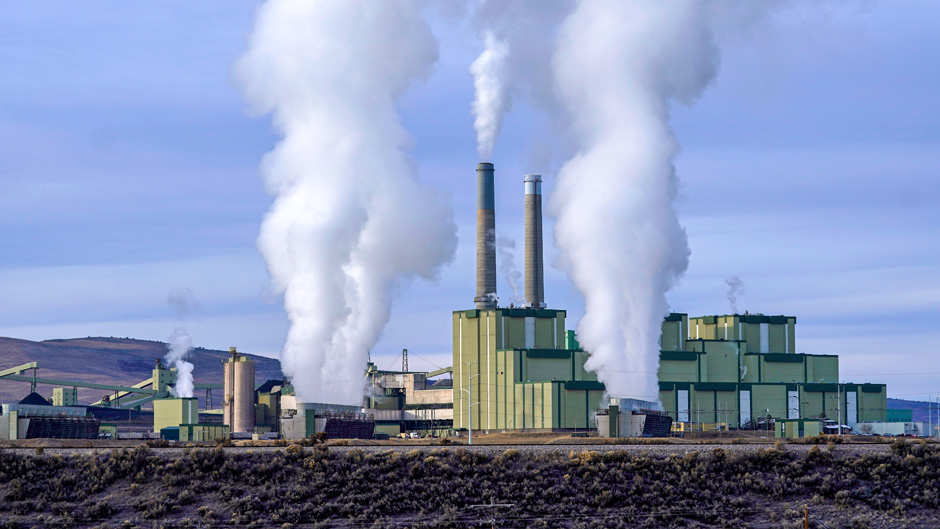With scientists continuing to warn that time is running out to avert a climate catastrophe, the U.S. Supreme Court on Thursday curbed the Environmental Protection Agency’s power to regulate greenhouse gas emissions from existing power plants, dealing a significant blow to the Biden administration’s plans to fight global warming.
In a 6-3 ruling on the case West Virginia v. Environmental Protection Agency, the court ruled that Congress, not the EPA, should have the authority to enact decisions on how to combat climate change.
“Capping carbon dioxide emissions at a level that will force a nationwide transition away from the use of coal to generate electricity may be a sensible ‘solution to the crisis of the day.’ But it is not plausible that Congress gave EPA the authority to adopt on its own such a regulatory scheme in Section 111(d),” Chief Justice John Roberts, referring to a section of the Clean Air Act, wrote for the majority. “A decision of such magnitude and consequence rests with Congress itself, or an agency acting pursuant to a clear delegation from that representative body.”
The court’s five other conservative justices joined Roberts.
In the dissent, Justice Elena Kagan, joined by Justices Stephen Breyer and Sonia Sotomayor, slammed the majority’s decision, writing that, “Whatever else this Court may know about, it does not have a clue about how to address climate change. And let’s say the obvious: The stakes here are high. Yet the Court today prevents congressionally authorized agency action to curb power plants’ carbon dioxide emissions. The Court appoints itself—instead of Congress or the expert agency—the decision-maker on climate policy. I cannot think of many things more frightening.”
Katharine Mach, an associate professor of environmental science and policy at the University of Miami Rosenstiel School of Marine and Atmospheric Science, also found the ruling disturbing.
“Responding to climate change requires flexibility and adaptive governance. At the local level and at the national level, we need to be able to rise to new challenges,” said Mach, who is a lead author on the Intergovernmental Panel on Climate Change Sixth Assessment Report. “The ruling today is worrisome in that it limits the government’s ability to help keep Americans safe and healthy as the climate continues to change and actions to rein in our emissions of heat trapping gases remain woefully inadequate.”
Thursday’s decision, which follows other controversial Supreme Court rulings of the past few days—from gun rights to religion to abortion—is a victory for Republican-led states and coal companies.
The case centers around the EPA’s Clean Power Plan, an Obama-era policy established in 2015 that set emission guidelines for states to follow in limiting carbon dioxide (CO₂) emissions from power plants. (In 2020, CO₂ accounted for about 79 percent of all U.S. greenhouse gas emissions from human activities, according to the EPA.)
Several states as well as other parties challenged the Clean Power Plan in federal court. And in 2016, the Supreme Court, in a 5-4 decision, stopped its implementation.
Then, during the Trump administration, the EPA repealed the plan, replacing it with new, more lenient guidelines for power plants.
A total of 22 U.S. states then challenged the repeal of the Obama plan, even as a group of other states and coal companies supported the Trump administration’s proposed guidelines.
Last year, a circuit court struck down the Trump administration’s repeal of the Obama regulation. And that’s when states appealed to the Supreme Court, asserting that the lower court’s ruling provided the EPA with broad powers over carbon emissions.

Jessica Owley, a professor of law and faculty director for the Environmental Law Program at the University of Miami School of Law, who specializes in climate change law and policy, answered a few critical questions about Thursday’s ruling.
The ruling significantly cuts back the EPA’s authority to regulate carbon emissions from existing power plants. How big of a blow is this to the Biden administration’s plans to combat climate change?
It is hard to say that this is a big blow to Biden’s climate plans mostly because Biden has announced goals but not a real plan to achieve them. This case examines the legitimacy of Obama’s Clean Power Plan, something the Biden administration already said that it wasn’t going to implement. However, the Biden administration still hasn’t announced its plan for implementing this part of the Clean Air Act. Without comprehensive climate change legislation, the Clean Air Act is our best shot for reducing carbon emissions, but no administration has yet figured out how to do so.
What will be the major impacts of today’s decision?
There are a few ways to think about the impacts of this decision. First, it hasn’t lifted any current limits on greenhouse gas emissions from our worst polluting plants because we don’t currently have any limits. It does, however, limit the Biden administration’s ability to regulate existing power plants. The EPA hasn’t released its new proposal. They promised it would come before the end of this year. So, we can’t yet say how much this decision will affect that new proposal.
The real harm from this decision is the court’s embrace of what it calls the “Major Questions Doctrine.” This new “doctrine” limits the action of agencies. Essentially the court is saying that the agency’s interpretation of the Clean Air Act has too much of an impact on the economy. The court argues that if Congress really wanted to give the EPA that much power, it would have stated so explicitly. Of course, Congress did explicitly acknowledge that the Clean Air Act would have far-reaching economic impacts when it was enacted back in the 1970s—they just didn’t understand the problems of climate change yet.
One could read the decision as a narrow issue of how to interpret the word “system” in the context of Section 111(d) of the Clean Air Act. The majority argues that it only refers to a technological device that would install on a facility. EPA saw “system” more broadly as something that could involve the energy sector and the mix of coal/gas/renewables. But I think it is a mistake to see it so narrowly. The real issue is not really what the word system means but the bigger idea of the power of the EPA to implement regulations that might affect the economy. We cannot launch a successful fight against climate change while maintaining the status quo, but that is how the court is confining agency action.
And it is very telling that the majority barely mentions climate change and doesn’t cite Massachusetts v. EPA—the case explicitly stating that the Clean Air Act requires the EPA to regulate greenhouse gases. Both are prominent parts of the dissent.
How will the ruling impact the way the U.S. is viewed on the world stage?
The U.S. is already viewed poorly on the world stage. You would be hard pressed to find a country that actually thinks the U.S. is doing a good job fighting climate change. This will make it extra challenging for the EPA to be taken seriously at COP27 in Egypt in November. The U.S. is still one of the largest economies, and John Kerry, the first United States special presidential envoy for climate, is well respected. But how can anyone believe that the U.S. can meet its commitments?
What other alternatives does the Biden administration have to address emissions?
Biden should be pressing for a climate change law. Congress should explicitly recognize the problems of climate change and authorize action. This should be our main message. Stop fiddling with the margins of a 50-year-old statute and tackle the problem head on. Biden could do a better job of reducing emissions from motor vehicles. He could use other pieces of the Clean Air Act—the ambient air quality standards, for example—or the EPA could work on a rule for existing power plants that deals with them on a plant-by-plant basis instead of looking at them as a whole. But frankly, I think the current court would find a reason to invalidate any EPA regulation addressing greenhouse gas emissions. The fact that they took this moot case demonstrates their distaste for EPA climate action.

